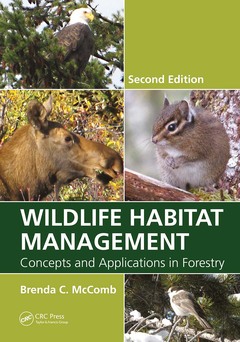Wildlife Habitat Management (2nd Ed.) Concepts and Applications in Forestry, Second Edition
Auteur : McComb Brenda C.

Shortlisted for the 2018 TWS Wildlife Publication Awards in the authored book category
In recent years, conflicts between ecological conservation and economic growth forced a reassessment of the motivations and goals of wildlife and forestry management. Focus shifted from game and commodity management to biodiversity conservation and ecological forestry. Previously separate fields such as forestry, biology, botany, and zoology merged into a common framework known as conservation biology and resource professionals began to approach natural resource problems in an interdisciplinary light.
Wildlife Habitat Management: Concepts and Applications in Forestry presents an integrated reference combining silvicultural and forest planning principles with principles of habitat ecology and conservation biology. With extensive references and case studies drawn from real situations, this book begins with general concepts such as habitat selection, forest composition, influences on habitat patterns, and the dynamics of disturbance ecology. It considers management approaches for specific habitats including even-aged and uneven-aged systems, riparian areas, and dead wood and highlights those approaches that will conserve and manage biodiversity. The author discusses assessment and prioritization policies, monitoring techniques, and ethical and legal issues that can have worldwide impact. Detailed appendices provide a glossary, scientific names, and tools for measuring and interpreting habitat elements. Writing in a species-specific manner, the author emphasizes the need to consider the potential effects of management decisions on biodiversity conservation and maintains a holistic approach throughout the book.
Drawing from the author?s more than 30 years working and teaching in natural resources conservation, Wildlife Habitat Management: Concepts and Applications in Forestry provides a synopsis of current preservation techniques and establishes a common body of knowledge from which to approach the conservation of biodiversity in the future.
Introduction. Humans as a Forest Dependent Species - Why Habitat Matters. Vertebrate Habitat Selection. Forest Structure and Composition. The Physical Environment and Habitat Patterns. Cultural Effects on Habitat Patterns. Disturbance Ecology and Habitat Dynamics. Silviculture and Habitat Management: Even-Aged Systems. Silviculture and Habitat Management: Uneven-Aged Systems. Desired Future Conditions. Riparian and Wetland Area Management. Dead Wood Management. Managing Fire in Forests. Urban Forests and Habitat Elements. Landscape Structure and Composition. Landscape Connections. Managing Woodlots in Agricultural Environments. Approaches to Biodiversity Conservation. Landscape Management Plans. Ecoregional Assessments and Prioritization. Viable Populations in Dynamic Forests. Monitoring Habitat Elements and Populations. Forest Sustainability and Habitat Management. Regulatory and Legal Considerations. Should I Manage a Forest? Appendices.
Brenda C. McComb, PhD, is Professor and Dean, Graduate School, Oregon State University, Corvallis. She is responsible for over 80 graduate programs and 4500 graduate students at a large research intensive university, having spent much of her 36-year career engaged in natural resources research, teaching, outreach, and administration.
Date de parution : 06-2021
17.8x25.4 cm
Disponible chez l'éditeur (délai d'approvisionnement : 14 jours).
Prix indicatif 56,31 €
Ajouter au panierDate de parution : 08-2015
17.8x25.4 cm
Thèmes de Wildlife Habitat Management :
Mots-clés :
Ruffed Grouse; Pe Rc; Humans as a Forest Dependent Species; Why Habitat Matters; Red Backed Vole; The Physical Environment and Habitat Patterns; Northern Red Oak; Silviculture and Habitat Management: Uneven-Aged Systems; Secondary Cavity Nesters; Landscape Structure and Composition; Thermal Neutral Zone; Forest Sustainability and Habitat Management; Habitat Elements; Longleaf Pine; Ecoregional Assessment; Oregon Coast Range; PNW; Desired Future Conditions; HCP; Shade Tolerant Species; Wood Ducks; Uneven Aged Stands; Endangered Species Act; Site Preparation; Landscape Management Plans; Moderate Severity Fires; Uneven Aged Management; Natal Dispersal Distances; Northern Spotted Owl; Vernal Pools; Salvage Logging



